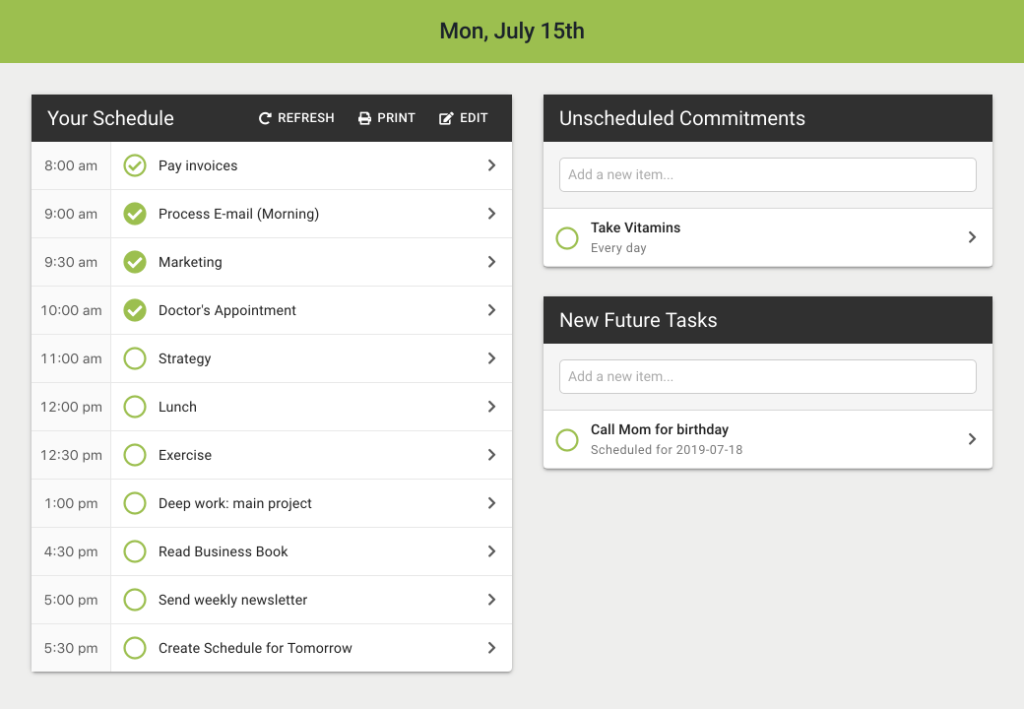Last week I fell out of my daily planning routine. Day after day I created…no plan.
The problem of falling out of a daily planning routine is that you lose all momentum, and then getting started is that much harder.
As your unplanned days pile up, you forget what it was like to plan out your day and the benefits that came from that. It can feel like you are still productive, but when you look back at your days, you realize you’re missing important tasks and activities.
Perhaps you can relate?
What happens when you don’t plan your day
When you don’t plan your day, you can still accomplish things. It’s just that the things you accomplish may not always be the things that lead to the biggest impacts in your life. A day without planning can still move us forward, albeit haphazardly.
You see, it’s not that we don’t have a plan for our day when we don’t write it down. It’s just that we keep it in our heads, where it’s easy to fudge over important details and not see the bigger picture.
When we don’t have a daily plan, we tend to have our to-dos scattered in multiple places: a master task list, an email inbox, a calendar (or two or three), a habit journal, etc.
We bounce from one thing to the other, feeling in the flow, but not necessarily taking the optimal path through our work.
We forget key tasks that we only remember at the end of the day as we look over what we did, or we don’t take the time to drill into the details and completely underestimate the amount of time a task needs. We spend way more time on lower priority tasks than we intended, because we didn’t take the time to time box them, and then run out of time to do important tasks that we left until later in the day.
Basically, we improv our day—which can work from time to time, but is not a way to make consistent progress.
Why you should do daily planning
The process of planning your day clarifies exactly what you intend to accomplish each day. It helps you weigh different priorities to focus on the ones that are most urgent or will have the highest impact for you.
Daily planning helps you collect all of your disparate to-dos into a single place, so you can have a single source of truth for what you need to do today. It prevents you from hiding surprises in your memory that don’t pop up until halfway through your day and lets you make trade-off decisions during the day on what to work on so you can be most effective.
While, as the founder of Day Optimizer, I’m partial to the CASE (Commit – Allocate – Schedule – Evaluate) planning workflow that I built into our software, any process you use to plan will be more effective than not planning at all.
Shifting our brains from execution mode to planning mode helps us look at our day from a different perspective to identify obstacles and opportunities we would otherwise not see.
And at the end of the day, a daily plan gives us something to evaluate our day against. If we don’t plan our days, it’s hard to remember what we thought we wanted to do at the beginning of our day. It’s easy to trick ourselves into thinking we did exactly what we planned.
When we write things down, it’s harder to ignore reality, which lets us improve both our planning and our execution processes for the next day.
How to restart your daily planning routine
Most people who have a daily planning routine don’t plan to stop planning. It just…happens.
Maybe you were sick? Or went on vacation? Or went to a work conference? Or had a family emergency? Or got so overwhelmed with work that you told yourself you didn’t have time to plan?
Whatever the reason, you stopped taking the time each day to plan. And then you lost the momentum. And building back that momentum can be hard.
So what are some strategies you can use to restart your daily planning routine?
- Set a Date
If you anticipate a disruption to your planning process, set a date in advance when you will resume it. For instance, if you are going on vacation, decide that the day before you return to work, you’ll create a quick daily plan for the next day. If the disruption was unanticipated and you’ve fallen out of your planning rhythm, pick a date in the future—tomorrow, next Monday—and use that as a time marker to restart your routine. - Start Slow
Don’t jump straight back into your old planning process. Take your time to ramp back up. If you are using a structured workflow like Day Optimizer, start by creating a Daily Commitment List for a few days first before doing more detailed planning like building a Time Bucket or creating a full Daily Schedule. - Divide & Conquer Your Backlog
Don’t attempt to tackle your backlog all at once. Divide your backlog into smaller groups that you can tackle a little bit each day. Focus on the items that have the highest urgency first, then the highest importance, then the rest. If using a digital tool like Day Optimizer that supports filtering your unfinished tasks, only show your most recently active tasks and then progressively look further in the past to the ones you previously put on the back burner. - Plan to Plan
Set aside a specific time in your day to make a daily plan. If you like to jump out of bed and dive right into work, make your schedule the night before. If you prefer starting your day with a ritual of intention, create your schedule in the morning to set the tone for your day. Either way, making a concrete decision on when you will plan your days makes it more likely you’ll stick to your intention. - Build a Rhythm
Focus less on getting the perfect plan in the beginning than on planning regularly. To build momentum, you first need to get started, then you need to build a rhythm. It is only after building a rhythm that you should look toward upgrading and enhancing your planning process—to create even better plans and to take into account factors like our circadian rhythms, energy cycles and how the types of tasks you do fit into these. - Upgrade Your Planning
Once you have a rhythm, then work to upgrade your planning process. If you’ve been creating daily commitment lists, consider creating a time bucket or a daily schedule instead. If you’ve been building a full schedule, consider how you can align what you do to the optimal time for you to do those things. For instance, if you are a morning person, doing your analytical work earlier and your creative work later will often make you more productive.
No matter which strategies you do, the important thing is to get started. Move first, then worry about improving afterwards.
Key Takeaways
Even the best of us fall out of our daily planning routine from time to time. What makes us successful in life isn’t when we lose our momentum, it’s what steps we take after that to rebuild that momentum.
Don’t stay stuck in the muck of days with no plans, where you are rushing from one thing to another without a sense of the bigger picture. Don’t leave it up to your memory or a hodgepodge of different systems to remember what’s important, use a deliberate process that helps you be effective in achieving your goals.
Take the time to be deliberate in rebuilding your momentum. Use the strategies listed above to start off slow, build momentum and then upgrade your planning process so you can return to a daily planning process that helps you become more productive with less stress.








